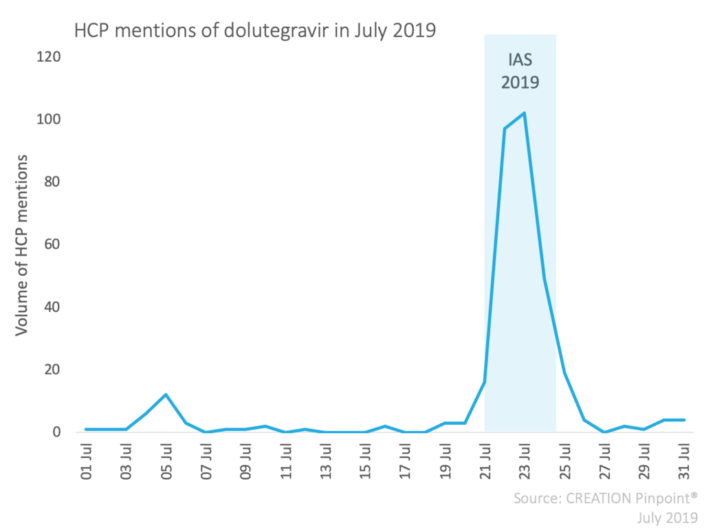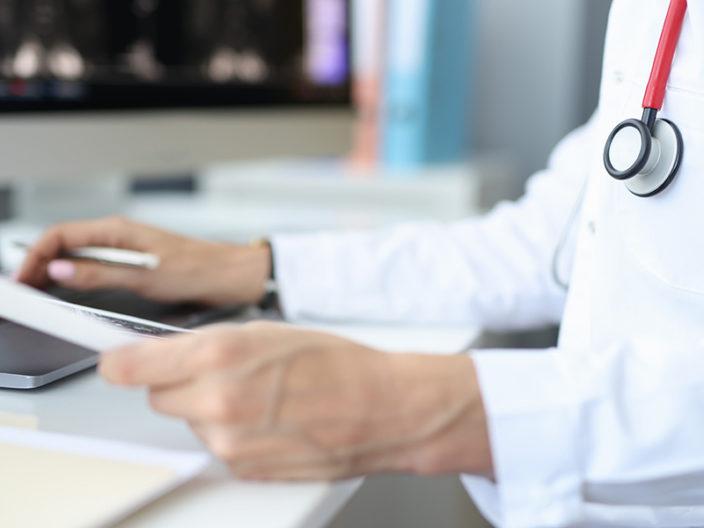In July 2023, the Joint United Nations Programme on HIV and AIDS, UNAIDS, released a report showing “the path that ends AIDS”. The report provided updates on the ‘95-95-95 Fast-track Targets’ previously established in 2015, which include:
- 95% of people living with HIV know their HIV status.
- 95% of people who know their status are receiving treatment.
- 95% of people on HIV treatment have a suppressed viral load so their immune system remains strong and the likelihood of their infection being passed on is greatly reduced.
Whilst this update was encouraging for many countries across Sub-Saharan Africa – Botswana, Rwanda, Tanzania and Zimbabwe to name a few – it presented more challenging considerations for the continent of South America, where findings from the report highlighted there are marked disparities in HIV prevention. CREATION.co wished to understand how online healthcare professionals (eHCPs) in this region are responding to this current landscape and to explore if they discuss the fact that marginalised groups tend to be disproportionately affected. Using CREATION Pinpoint®, over 7,500 South America eHCP posts were found, discussing HIV or AIDS or both, across social media platforms including X, Instagram, LinkedIn and Sermo (a private social media network for physicians), in Spanish, Portuguese and English.
eHCPs in Brazil contributed the most posts in the study. However, there were active eHCPs engaging in the HIV conversation across South America.

Largely the level of eHCP conversation in each country corresponded to the number of HIV cases identified by the WHO in 2022. However, some countries engaged in the conversation proportionally far more than the number of cases and some vice versa. It can be seen that Brazil contributed the most to the online conversation, 27% among the top eight active South America countries.
However, this is proportionally far lower than the 59% of HIV cases (among these same eight countries) reported in Brazil – indeed it is even more surprising given that without the most active eHCP, Vinícius Borges, HCPs in Brazil would have only shared 929 HIV posts. Conversely, Chile and Venezuela had proportionally more eHCP posts than HIV cases – 12% more in both countries.
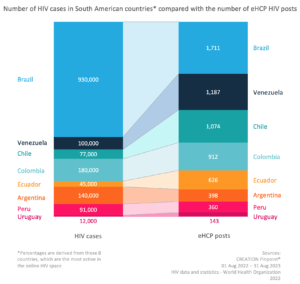
Surprisingly for a country which boasts almost 50% of the population in South America, Brazil made up only 20% of the eHCPs in the conversation. This low number may indicate the relatively small sample of HCPs who are trying to spread HIV messaging online. Could understanding how to engage DOLs effectively help with this promotion of HIV conversation in the country?
The five most active eHCPs in the HIV and AIDS conversation were from five different South American countries. When looking to work in local markets, it is important to understand the differences in how eHCPs engage in content across different countries – indeed intra-country and inter-country digital behaviours will range vastly between DOLs.
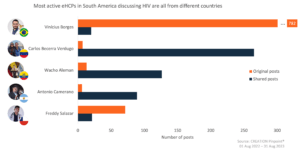
eHCPs across South America brought attention to some of the most at-risk groups of HIV.
The latest UNAIDS data revealed that Latin America (including South America and an additional seven countries) has the largest number of hate crimes against lesbian, gay, bisexual, transgender and intersex people in the world. This is increasingly concerning considering the prevalence of HIV in this community, and the potential impact that hostility and prejudice towards this group could have on accessing diagnosis and treatment.
Hoje é o dia mundial de combate à AIDS. Ano passado tivemos ~50 mil casos diagnosticados no Brasil. A infecção ainda afeta de maneira desproporcional os negros, homens que fazem sexo com homens, usuários de drogas e transsexuais. Precisamos fortalecer políticas para esses grupos.
— Bruno Ishigami (@b_ishigami) December 1, 2022
However, there was some encouragement towards this topic when analysing the eHCP conversation. LGBTQIA+ was the most discussed ‘at-risk’ group across the continent, with it being the most discussed group for seven of the eight top posting countries – only eHCPs in Uruguay did not mention the group. Additionally, eHCPs shared the importance of conferences addressing the latest breakthroughs surrounding HIV – with specific references to at-risk groups, as Dr Borges did when referencing a recent study – “released at the world’s largest HIV conference” – which provided gay and bisexual men and trans women with the antibiotic doxycycline to take after condomless sex.
Um estudo recente, o DoxyPEP, que forneceu a homens gays e bissexuais (HSH) e mulheres trans (MT) o antibiótico doxiciclina para tomar após o sexo sem preservativo foi divulgado no maior congresso sobre HIV do mundo.
— Vinícius Borges (@DoutorMaravilha) February 12, 2023
On the other side of this, while sex workers make up a large percentage of people living with HIV in South America, this group was rarely discussed online by eHCPs. In only three countries did eHCPs mention this group online, even when positive initiatives were launched, they received little traction among eHCPs. A serious challenge that South America faces is normalising beneficial awareness conversation around these taboo subjects.
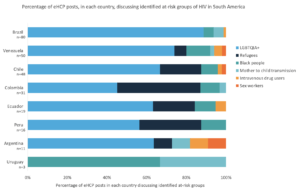
As can be seen above, refugees were spoken about most by eHCPs in Colombia. A large portion of this conversation drew attention to the Venezuelan refugee crisis and the role Colombia has had in supporting people adversely affected. eHCPs in Colombia shared information online about how Venezuelan migrants and refugees may get help with the treatment of HIV.
Les comparto esta info de @AidForAidsCol para lxs venezolanxs migrantes irregulares que quieran tomar #PrEP 💊 También con ellos pueden conseguir ayuda con el tratamiento para el #VIH ✨ pic.twitter.com/U7lfUoXzjD
— Miguel A López-López (@MiguelAngelopez) August 16, 2023
eHCPs in South America mentioned treatment more than any other topic alongside HIV.

eHCPs assessed the present treatment landscape as well as looking towards the potential future treatments when discussing HIV. Accessibility and administration were considered when assessing the viability and potential of treatments for people with HIV. With many different competitors in the treatment landscape across South America it is interesting to see the online discussions about different treatments and the potential to generate unique commercial insights from these conversations.
View this post on Instagram
Upon studying the medications discussed by eHCPs in South America, PrEP (pre-exposure prophylaxis) was more discussed than ART (antiretroviral therapy) or PEP (post-exposure prophylaxis). Brazil made up over 50% of the PrEP conversation. However, when discussing ART, eHCPs in Brazil only contributed 18% of the posts to the conversation. Conversely, in Chile, Venezuela, Ecuador and Peru ART was discussed more than PrEP. There is a hypothesis that this could be as a result of the national guidelines and distribution of PrEP to key populations/community-based distribution in some South America countries which is not currently seen in other South American countries (including Chile and Venezuela).
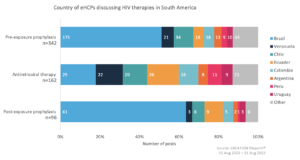
Further cross-country analysis revealed the varying levels of eHCP activity within different topics. Brazil was the standalone country in which eHCPs discussed research and data more than diagnosis and treatment. More countries discussed treatment than diagnosis and research and data – this included Peru, Ecuador, Colombia and Argentina. Much of this conversation into treatment focused on the lack of adherence to treatment as well as the inaccessibility for some patients. Additionally, eHCPs in three countries – Venezuela, Chile and Uruguay – focused more of their HIV conversation towards diagnosis, highlighting the importance of this process and also aimed to combat stigma for those diagnosed.

Through the research we can also see the potential impact eHCP conversation has had on the aforementioned ‘95-95-95 Fast-track Targets’. Ecuador is the only country in South America to have already attained the 2030 target of 95% of people living with HIV knowing their HIV status. Ecuador is also the country with the highest percentage of eHCP posts discussing awareness and education online. Highlighting the potential importance of eHCP conversation on health policy.
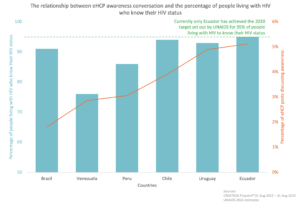
How can pharma help eHCPs influence the HIV epidemic in South America?
From the UNAIDS ‘95-95-95 Fast-track Targets’, a clear path has been identified in which to curtail the HIV epidemic in South America. However, as highlighted, many countries in South America are currently falling short of these targets. Greater use of social media in raising awareness for HIV could support these efforts through eHCPs providing consumable content to the general public to help them in their understanding of the virus.
Moreover, more conversations and transparency around the effectiveness and usability of treatments online would keep people informed and educated about their health. Additionally, as there are many groups within South America who are more likely to be predisposed to HIV than in other continents, it is vital that these groups feel heard and supported when the data suggests this hasn’t always been the case. Patient advocacy groups are a vital resource which can help provide comfort and encouragement to those who are in need of it and supporting these groups would be a big forward step in tackling the HIV crisis in South America.
Finally, when discussing these findings it is of worth to note that while 80.6% of South America’s population are ‘internet users’, 84.8 million people do not use the internet in South America. How could HCPs help in providing information to this sub-group? Collaboration between DOLs and KOLs could help develop this type of content and ensure it is shared to a wider audience.
To understand the difference between DOLs and KOLs and why it matters to pharma, please see the article written by CREATION.co’s Head of Client Marketing Katie Kennedy. If you would like to find out more about this research or understand healthcare professionals’ views and digital behaviours in your market and therapy area please get in touch, we’d love to hear from you.
 By Mark Sullivan
By Mark Sullivan 
